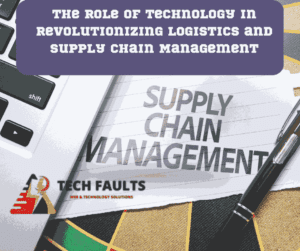Technology’s transformative impact on logistics and supply chains has revolutionized how organizations, companies, and agencies operate. With improved efficiency and visibility, goods and services reach customers faster and more effectively. Real-time tracking, automation, and data analytics have reshaped supply chain management, ensuring seamless and efficient operations.
Introduction
In logistics and supply chain management, various processes transport goods and services from their origins to their final destinations. Today’s dynamic economy requires these processes to remain competitive. Logistics and supply chains use manual labor, causing delays, inefficiencies, and high costs. Technology improved efficiency and reduced problems. Technological advancements have enhanced these fields’ efficiency, dependability, and cost-effectiveness.
Impact of Technology on Logistics and Supply Chain Management

Automation of Processes:
One of the significant impacts of technology on logistics and supply chain management is the automation of processes. Automation optimizes operations, cuts expenses, and boosts efficiency, benefiting businesses significantly. Inventory management has become more effective thanks to automated warehouse technologies, which also cut down on mistakes and delays. Moreover, mechanical tracking devices have made it simpler to follow goods by giving real-time updates on their position and state.
Improved Data Management:
Data collection, storage, and analysis have become more accessible thanks to technology. Real-time data availability enables smart decisions, better operations, and happier customers, transforming the logistics and supply chain industry. For instance, logistics and supply chain management and data analytics have enabled businesses to identify patterns, trends, and anomalies, helping them make better decisions.
Increased Visibility:
Technology has also increased visibility in logistics and supply chain management. Businesses can now track their goods from the point of origin to the end of consumption. It has enabled companies to manage their operations better, lowering the possibility of delays and raising customer satisfaction. For instance, the ability to trace goods with GPS tracking systems has decreased the likelihood of loss and theft.
Improved Communication:
Technology has improved communication in logistics and supply chain management. With email, instant messaging, and video conferencing, businesses can now effortlessly connect with suppliers, consumers, and stakeholders, fostering smoother communication and collaboration. Technology boosted cooperation, cut reaction times, and enhanced productivity, delivering exceptional logistics and supply chain management results.
Enhanced Customer Experience:
Technology has enhanced the customer experience in logistics and supply chain management. Now that shipments can be tracked in real-time, customers know to plan their operations efficiently. It has decreased the possibility of delays, boosted client happiness, and strengthened loyalty.
Reduced Costs:
Technology has also reduced the need for logistics and supply chain management. Automation cuts labor costs, boosts efficiency, and minimizes errors—transforming businesses for the better. Data analytics optimizes operations, cutting waste and increasing profitability. Companies gain insights from vast data, improving supply chain efficiency and making informed decisions for better outcomes.
Improved Sustainability:
Finally, technology has improved sustainability in logistics and supply chain management. Eco-friendly technologies like electric vehicles, renewable energy, and sustainable packaging have cut logistics’ carbon footprint. They help protect the environment while keeping supply chains efficient and responsible. Technology has helped businesses reduce environmental impact, meet regulations, and enhance their reputation through improved supply chain management.
Conclusion
In conclusion, technology has played an important role in logistics and supply chains. Automation, improved data management, increased visibility, improved communication, enhanced customer experience, reduced costs, and improved sustainability are some ways that technology has impacted logistics and supply chain management. As businesses adopt new technologies, we expect further efficiency, cost-effectiveness, and sustainability improvements. Companies must keep up with the most recent technical developments to remain competitive.
FAQs:
Q: What are logistics and supply chain management? Logistics and supply chain management handle the smooth movement of goods and services from their source to the customers. It’s all about organizing and managing this flow effectively.
Q: How does technology impact logistics and supply chain management?
Technology revolutionized logistics: efficiency, reliability, cost-effectiveness—benefiting businesses and customers. Automation of processes, improved data management, increased visibility, improved communication, enhanced customer experience, reduced costs, and improved sustainability are ways technology has impacted logistics and supply chain management.
Q: How has technology improved sustainability in logistics and supply chain management? Eco-friendly techs like electric vehicles, renewable energy, and sustainable packaging cut logistics’ carbon footprint, promoting greener supply chains.
Logistics & supply chain technology reduces environmental impact, meets regulations, and boosts reputation by optimizing operations, tracking emissions, and promoting sustainability.
Q: Why must businesses stay current with technological logistics and supply chain management advancements?
To stay competitive, businesses must stay updated on the latest technological advancements.
Doing so can enhance their efficiency, cost-effectiveness, and sustainability in logistics and supply chain operations. Embracing new tech streamlines processes, cuts costs fosters eco-friendly practices, and ensures market success—a win-win approach for companies.
Embracing innovation boosts efficiency and sustainability, securing a competitive edge.
Q: What are some benefits of logistics and supply chain management technology? Technology has brought several advantages in logistics and supply chain management. These include automating processes, enhanced data management, increasing visibility, improving communication, providing a better customer experience, reducing costs, and enhancing sustainability.
